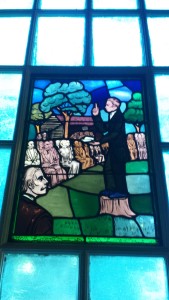For a historian, there is nothing quite like a visit to a preserved historic structure where something significant began, such as Independence Hall in Philadelphia or the log cabin in which Abraham Lincoln was born. Such sites of course have a history of their own which is totally separate from the single moment in which something of lasting significance occurred within their walls, but it is that lone event which transforms them into something with more meaning. Being able to walk in and around them facilitates a connection with the past one can achieve in no other way.
Recently I had an opportunity to visit such a site in the form of a superbly preserved 1791 log church in a memorial park outside of the small town of Paris, Kentucky known as the Cane Ridge Meeting House. The original wooden structure today stands within a modern stone structure resembling a church. The setting was beautiful, the guide gracious and knowledgeable, and history remarkable.
The structure was ground zero for the famed “Cane Ridge Revival” of 1801—believed to have been perhaps the largest “camp meeting” held in America during the so-called Second Great Awakening, with at least 10,000 people in attendance. It is also the congregation from which eventually emanated perhaps the first and one of the most wide-reaching entirely American religious movements, known to historians of religion as the “Restoration Movement.” This movement sought unity among all Christians by attempting to practice Christianity as it was described in the New Testament, finding common ground in essential tenets of faith with other believers, eschewing any denominational label other than “Christian,” and insisting on the local autonomy of individual congregations. The Cane Ridge church is the mother church for the Christian Church (Disciples of Christ), the Church of Christ, and several associated faiths.
Having grown up in the religious tradition to which Cane Ridge gave birth, mine was a personally intriguing and meaningful visit. But in a broader sense as a student of American history, I found it fascinating to be able to sit in a place with such resonance whose connection to modern society could be traced with such precision. Kudos to the numerous volunteers, several organizations, and historians across the nation that have endeavored to preserve and interpret this unique piece of American history.
JMB








